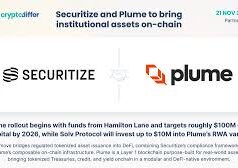After nearly five years of legal wrangling, the high-profile lawsuit between the U.S. Securities and Exchange Commission (SEC) and Ripple Labs has finally reached its end. On August 7, 2025, both parties filed a joint motion with the U.S. Court of Appeals for the Second Circuit to dismiss their respective appeals, effectively closing one of the most significant legal battles in cryptocurrency history. This resolution not only marks a turning point for Ripple and its native token, XRP, but also carries profound implications for the broader digital asset industry. Let’s unpack what happened, why it’s a big deal, and what lies ahead for Ripple and the crypto world.
The Journey to Resolution
The SEC filed its lawsuit against Ripple Labs in December 2020, alleging that the company’s sale of XRP constituted an unregistered securities offering. The case, centered on whether XRP qualified as a security, became a litmus test for how U.S. courts would interpret and regulate digital assets. The legal saga saw twists and turns, including a pivotal July 2023 ruling by Judge Analisa Torres. She delivered a split decision: Ripple’s programmatic sales of XRP to retail investors via exchanges did not violate securities laws, but its direct sales to institutional investors did. This partial victory for Ripple set a $125 million penalty and a permanent injunction barring future securities law violations.
Both sides initially appealed—Ripple to challenge the institutional sales ruling, and the SEC to contest the retail sales decision. However, a shift in the SEC’s leadership and regulatory approach under new Chair Paul Atkins, confirmed in April 2025, paved the way for settlement talks. By April 2025, Ripple and the SEC jointly requested a 60-day pause in appeals to finalize a settlement, which the court approved. Fast forward to August 2025, and the joint motion to drop all appeals was filed, signaling both parties’ agreement to let the 2023 ruling stand.
The Bigger Picture
The conclusion of this case is more than just a win for Ripple—it’s a defining moment for the cryptocurrency industry. The 2023 ruling clarified that XRP sales on public exchanges don’t meet the criteria for securities offerings, a precedent that could shield other crypto projects from similar enforcement actions. This outcome has been hailed as a partial victory for the industry, especially as the SEC, under its new leadership, appears to be softening its aggressive stance on crypto enforcement. Posts on X reflect this sentiment, with users like @SMQKEDQG noting that the case’s resolution, combined with potential market structure legislation, could bring much-needed regulatory clarity to the U.S. crypto space
For Ripple, the end of the lawsuit removes a significant overhang. The $125 million fine, now in escrow and set to be transferred to the U.S. Treasury, is a fraction of the $2 billion the SEC initially sought. Despite attempts to reduce the penalty, Judge Torres upheld the full amount in June 2025, emphasizing Ripple’s ongoing obligation to comply with securities laws. The market responded positively, with XRP’s price surging 13% after the announcement, climbing to $3.31 after hitting a 2025 peak of $3.56 in July. This rally reflects investor optimism about Ripple’s ability to move forward unencumbered.
Ripple’s Path Forward
With the legal cloud lifted, Ripple is poised to accelerate its growth. The company has already signaled ambitious plans, including the acquisition of Rail Financial in August 2025 to bolster its global payments network and stablecoin offerings like RLUSD. As Ripple’s CEO Brad Garlinghouse put it, it’s “back to business.” The company’s focus on cross-border payments, which it argues are faster and cheaper using XRP and the XRP Ledger, could gain traction in jurisdictions with clearer regulations. Events like Ripple Swell 2025, featuring high-profile speakers like Nasdaq’s Adena Friedman, underscore Ripple’s intent to position itself as a leader in financial technology and blockchain innovation.
However, challenges remain. The permanent injunction means Ripple must tread carefully in its institutional sales to avoid future SEC scrutiny. Legal observers also note that while the case sets a precedent, it doesn’t fully resolve the broader question of how digital assets should be classified under U.S. law. The lack of a comprehensive regulatory framework continues to create uncertainty, though Ripple’s chief legal officer, Stuart Alderoty, has called for clearer legislative guidance.
Implications for Crypto Regulation
The SEC-Ripple case has been a lightning rod for debates about crypto regulation. The SEC’s initial approach under former Chair Gary Gensler was marked by enforcement-heavy tactics, but the shift under Atkins suggests a more crypto-friendly stance. The agency’s decision to drop appeals aligns with a broader retreat from enforcement actions against crypto firms, a move some attribute to political changes following Donald Trump’s return to the White House. Ripple’s $5 million XRP donation to Trump’s inauguration fund and the attendance of Garlinghouse and Alderoty at related events hint at strategic alignment with the new administration.
The case also highlights the judiciary’s growing role in shaping crypto policy. Judge Torres’ 2023 ruling, now finalized, could influence future cases, particularly in the Second Circuit, where courts have occasionally diverged on whether investor knowledge of a token’s issuer is required for it to qualify as a security. As Congressman Ritchie Torres noted on X, combining this resolution with legislative efforts like a market structure bill could provide the clarity the industry craves.
Looking Ahead
The end of the SEC-Ripple saga doesn’t mean the end of regulatory battles for crypto, but it’s a significant milestone. For Ripple, it’s an opportunity to refocus on innovation and expansion, unburdened by legal uncertainty. For the broader industry, the case offers a blueprint for navigating securities laws, though questions about token classification persist. As the crypto market evolves, stakeholders will be watching closely to see how regulators and lawmakers build on this precedent.
In the meantime, XRP holders and crypto enthusiasts are celebrating. Posts on X, like those from @Jenny_Solstice, capture the excitement, with some predicting XRP could break past $5 as regulatory fears fade. While such predictions are speculative, they reflect the optimism surrounding Ripple’s future. For now, the industry can take a moment to breathe, knowing one of its biggest legal battles is finally over.
Sources:
- Cointelegraph: SEC, Ripple lawsuit to end after joint agreement to drop appeals
- Cryptonews: Ripple and SEC Drop Final Appeals in Landmark Case
- CryptoSlate: SEC and Ripple file joint motion to pause appeals to pursue settlement terms
- Crypto Briefing: Ripple, SEC file joint motion to pause appeals to finalize case resolution
- Lexology: SEC appeals lower court decision in Ripple, but outcome may hinge on new Administration’s priorities
- X posts reflecting community sentiment




























XRP hitting $3.30 is awesome, but can it break $3.50 resistance?
Ripple vs. SEC done after 4 years? XRP at $3.30 and maybe hitting $7 if ETFs get approved
I’m stoked but kinda skeptical—$50M fine’s nothing for Ripple, but will this really open the floodgates for ETFs
Think this means XRP ETFs are a lock now
Man, Ripple dodging the SEC bullet feels so good!
Okay, the SEC-Ripple saga’s over, and XRP’s not a security for retail? That’s a win for all crypto
Ripple beating the SEC is HUGE! XRP jumping 13% to $3.30 is no joke
Awesome post, makes me wanna HODL XRP harder!